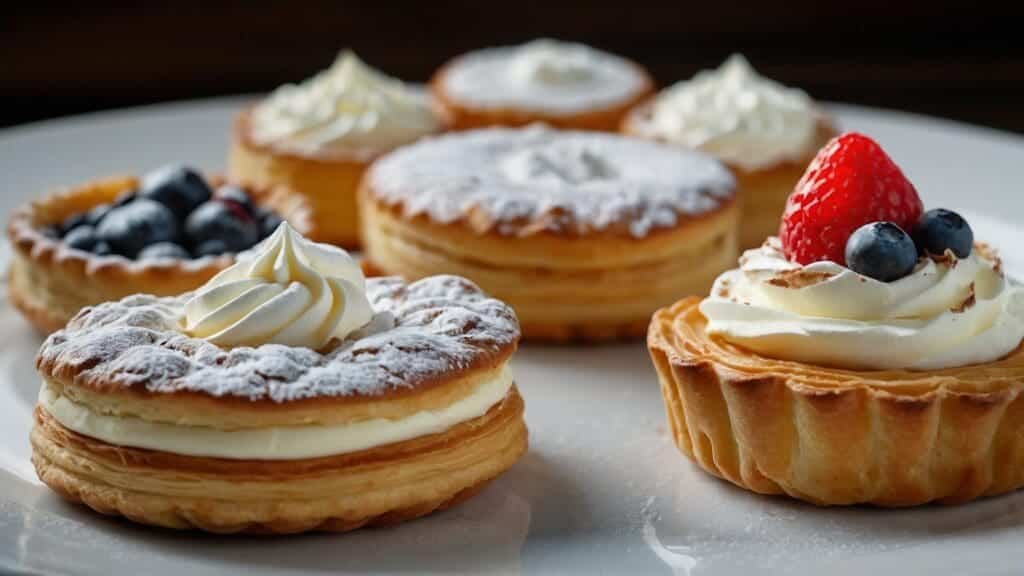French pastries are renowned worldwide for their delicate textures, rich flavors, and intricate designs. From buttery croissants to elegant éclairs, French pastries have a long and storied history that continues to influence baking across the globe. The journey of French pastries is intertwined with the evolution of French cuisine, royal courts, and the artistry of pastry chefs. This article explores the fascinating history of French pastries, shedding light on their origins, evolution, and cultural significance.

Origins of French Pastries
The roots of French pastry making can be traced back to ancient civilizations, but it was during the Renaissance period that the foundation of modern French pastries began to take shape. The influence of Italian cuisine, particularly during the reign of Catherine de’ Medici, who married Henry II of France in 1533, brought the art of pastry making to the French court. Italian chefs introduced new techniques and ingredients, including puff pastry, which laid the groundwork for the creation of many iconic French pastries.
The Influence of the Renaissance
The Renaissance era was a time of cultural exchange across Europe, and Italy’s culinary innovations deeply influenced French gastronomy. It was during this period that French pastry chefs began experimenting with new ingredients like butter, sugar, and eggs, which contributed to the rise of pastries as an art form. Early French pastries were often made with almond paste, fruit preserves, and honey, and were initially reserved for the nobility and royal courts.
The Evolution of French Pastry Styles
As time progressed, French pastries evolved and diversified, becoming more refined and accessible to the public. The 17th and 18th centuries saw the establishment of pastry shops in Paris, making these indulgent treats available to a wider audience. During the reign of Louis XIV, French pastry chefs began developing elaborate sweets and desserts for the royal court, incorporating new techniques and flourishes to create pastries that were as much about presentation as they were about flavor.
The Birth of Classic French Pastries
The 19th century marked a golden age for French pastry making. As Paris became the center of culinary innovation, the first modern bakeries and pastry shops emerged, and French pastries began to take on their recognizable forms. During this time, classic pastries like croissants, éclairs, tarts, and mille-feuille were perfected. The invention of puff pastry, pâte à choux, and other essential doughs gave rise to the pastries that are now synonymous with French baking.
Pastry chefs such as Marie-Antoine Carême and Auguste Escoffier played pivotal roles in elevating French pastry-making techniques. Carême, in particular, is known for his elaborate and ornate pastries, while Escoffier streamlined and modernized French pastry techniques, making them more efficient and accessible.
The Role of Pastry Chefs and Pâtisseries
By the 20th century, French pastries had become a cornerstone of French culture and daily life. Pâtisseries, or pastry shops, flourished throughout Paris and beyond, offering an array of beautifully crafted pastries. These establishments were more than just places to buy sweets; they became social hubs where people could gather and enjoy pastries paired with coffee or tea.
French pastry chefs, or pâtissiers, became highly respected for their expertise in the delicate art of pastry-making. The meticulous techniques and attention to detail required to create French pastries raised these treats to the level of fine art. French pastry chefs also embraced innovation, incorporating modern ingredients and flavors while maintaining a reverence for traditional recipes and techniques.
The Influence of French Pastry on the World
As the popularity of French pastries spread beyond France, their influence permeated global baking traditions. The techniques and styles of French pastries have been adopted and adapted by bakers around the world. Croissants, for example, have become a breakfast staple in many countries, while pastries like macarons and éclairs are beloved in bakeries worldwide.
French pastry chefs have also played a significant role in the development of global pastry competitions, with events such as the Coupe du Monde de la Pâtisserie showcasing the skill and artistry of pastry chefs from across the world. The mastery of French pastry-making continues to inspire generations of bakers, who strive to replicate the finesse and precision of the classics while pushing the boundaries of flavor and design.
Conclusion
The history of French pastries is a tale of innovation, refinement, and cultural exchange. From their humble beginnings in the royal courts of France to their widespread popularity today, French pastries have become an enduring symbol of culinary excellence. The artistry of French pastry chefs, coupled with centuries of experimentation and tradition, has created a legacy that continues to shape the world of baking. Whether you’re enjoying a delicate éclair or a perfectly flaky croissant, you’re partaking in a centuries-old tradition that has elevated the art of pastry-making to new heights.

